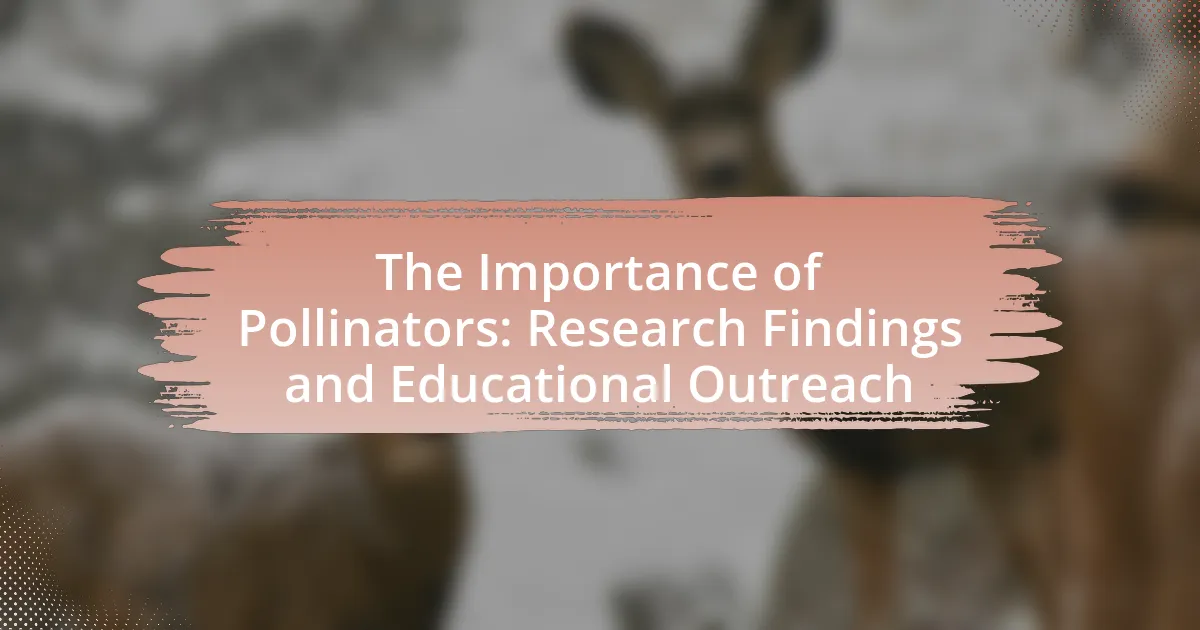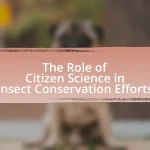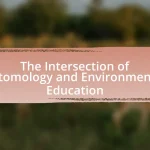Pollinators, including bees and butterflies, play a vital role in the reproduction of approximately 75% of flowering plants and 35% of global food crops, contributing significantly to biodiversity and ecosystem health. Their economic impact is substantial, with pollination services valued between $235 to $577 billion annually, underscoring their importance in agriculture and food security. However, pollinators face numerous threats such as habitat loss, pesticide exposure, and climate change, leading to population declines that jeopardize both ecological balance and agricultural productivity. This article explores the critical findings from recent research on pollinators, the economic implications of their decline, and the importance of educational outreach and community initiatives aimed at their conservation.
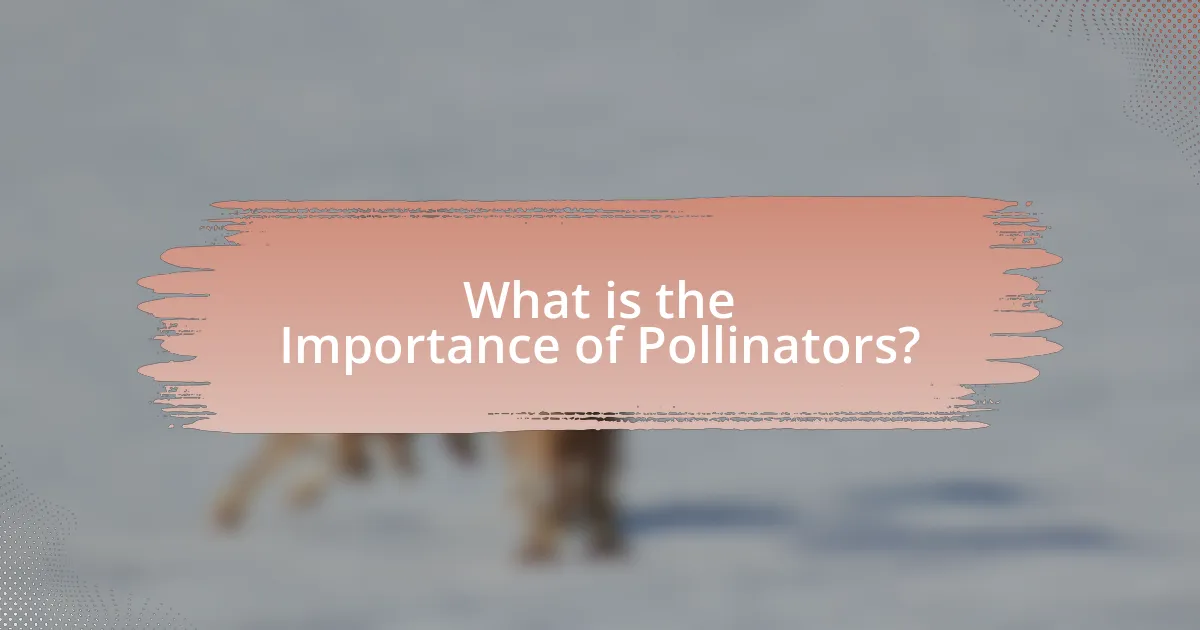
What is the Importance of Pollinators?
Pollinators are crucial for the reproduction of approximately 75% of flowering plants and about 35% of global food crops. Their role in transferring pollen between flowers enables fertilization, leading to the production of fruits and seeds. This process is essential for maintaining biodiversity and supporting ecosystems. For instance, the Food and Agriculture Organization (FAO) reports that pollinators contribute to the production of crops worth over $235 billion annually worldwide. Without pollinators, many plants would decline, leading to reduced food availability and negative impacts on wildlife that depend on these plants for habitat and sustenance.
Why are pollinators crucial for ecosystems?
Pollinators are crucial for ecosystems because they facilitate the reproduction of flowering plants through the transfer of pollen. This process is essential for the production of fruits and seeds, which serve as food sources for various organisms, including humans. According to the Food and Agriculture Organization, approximately 75% of the world’s food crops depend on pollinators, highlighting their vital role in maintaining biodiversity and ecosystem health. Without pollinators, many plants would fail to reproduce, leading to a decline in plant diversity and the animals that rely on those plants for survival.
What roles do pollinators play in plant reproduction?
Pollinators are essential for plant reproduction as they facilitate the transfer of pollen from the male parts of flowers (anthers) to the female parts (stigmas), enabling fertilization. This process leads to the production of seeds and fruits, which are crucial for the continuation of plant species. According to the Food and Agriculture Organization, approximately 75% of the world’s flowering plants depend on animal pollinators, highlighting their critical role in maintaining biodiversity and supporting ecosystems.
How do pollinators contribute to biodiversity?
Pollinators contribute to biodiversity by facilitating the reproduction of flowering plants, which in turn supports diverse ecosystems. Approximately 75% of the world’s flowering plants depend on animal pollinators for reproduction, including many crops and wild plants. This interaction enhances genetic diversity within plant populations, leading to a greater variety of species. Studies indicate that ecosystems with higher plant diversity are more resilient and provide essential services, such as habitat for wildlife and improved soil health. Therefore, the role of pollinators is critical in maintaining ecological balance and promoting biodiversity.
What economic impacts do pollinators have?
Pollinators significantly contribute to the economy by enhancing agricultural productivity and supporting food security. They are responsible for the pollination of approximately 75% of the world’s flowering plants, including about 35% of global food crops, which translates to an estimated economic value of $235 to $577 billion annually. This economic impact is evident in crops such as fruits, vegetables, and nuts, where pollination directly influences yield and quality. For instance, in the United States alone, the economic value of pollination services provided by bees is estimated to be around $15 billion each year. Thus, the economic impacts of pollinators are substantial, underpinning both agricultural success and broader economic stability.
How do pollinators affect agricultural productivity?
Pollinators significantly enhance agricultural productivity by facilitating the reproduction of flowering plants, which are essential for crop yields. Approximately 75% of the world’s food crops depend on animal pollination, according to the Food and Agriculture Organization (FAO). This process increases the quantity and quality of fruits, vegetables, and nuts, leading to higher economic returns for farmers. For instance, a study published in the journal “Science” found that pollination services contribute an estimated $235 to $577 billion annually to global crop production. Therefore, the presence of pollinators directly correlates with improved agricultural output and economic viability.
What is the value of pollination services to the economy?
Pollination services are valued at approximately $235 to $577 billion annually to the global economy. This economic contribution arises from the essential role that pollinators, such as bees and butterflies, play in the production of fruits, vegetables, and nuts, which account for a significant portion of agricultural output. For instance, the Food and Agriculture Organization (FAO) reports that about 75% of the world’s food crops depend on pollination, highlighting the critical economic impact of these services.
What threats do pollinators face?
Pollinators face several significant threats, including habitat loss, pesticide exposure, climate change, and disease. Habitat loss occurs due to urbanization and agricultural expansion, which reduces the availability of food and nesting sites for pollinators. Pesticide exposure, particularly from neonicotinoids, has been linked to harmful effects on bee populations, leading to decreased survival and reproductive success. Climate change alters the timing of flowering plants and disrupts the synchrony between pollinators and their food sources. Additionally, diseases and parasites, such as Varroa mites, pose serious risks to pollinator health, contributing to population declines. These threats collectively endanger the vital ecosystem services that pollinators provide, including crop pollination and biodiversity maintenance.
How does habitat loss impact pollinator populations?
Habitat loss significantly reduces pollinator populations by diminishing their food sources and nesting sites. When natural habitats are destroyed or fragmented, the availability of flowering plants, which provide nectar and pollen, decreases, leading to nutritional stress for pollinators. Research indicates that areas with high habitat diversity support greater pollinator abundance and diversity; for instance, a study published in “Ecological Applications” found that landscapes with more varied habitats had up to 50% more pollinator species compared to monoculture areas. Consequently, habitat loss not only threatens individual pollinator species but also disrupts the essential ecosystem services they provide, such as crop pollination, which is vital for food production.
What role do pesticides play in pollinator decline?
Pesticides significantly contribute to pollinator decline by causing direct harm and disrupting their ecosystems. Specifically, neonicotinoids, a class of systemic insecticides, have been shown to impair the foraging behavior, reproduction, and survival of bees. Research published in the journal “Nature” by Goulson et al. (2015) indicates that exposure to these chemicals can lead to reduced colony growth and increased mortality rates among pollinators. Additionally, pesticides can contaminate floral resources, further exposing pollinators to harmful substances and diminishing their populations.
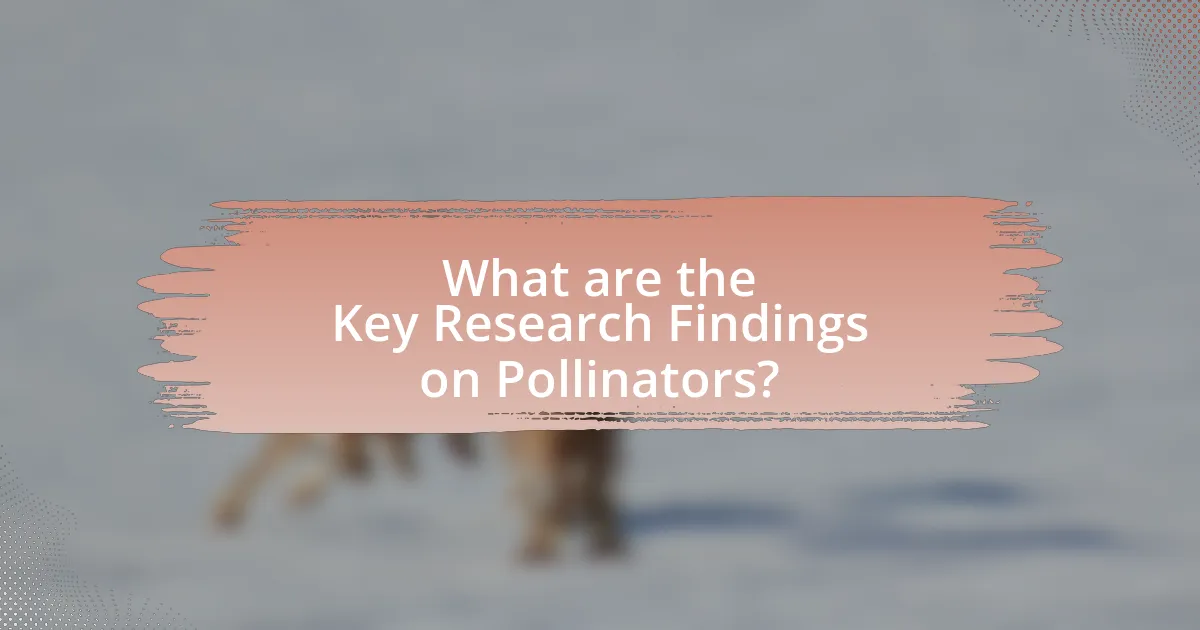
What are the Key Research Findings on Pollinators?
Key research findings on pollinators indicate that they are essential for global food production, with approximately 75% of the world’s food crops relying on animal pollination. Studies show that pollinators, particularly bees, contribute to the production of fruits, vegetables, and nuts, significantly impacting agricultural economies. Research published in “Nature” by Garibaldi et al. (2013) highlights that the decline in pollinator populations threatens food security and biodiversity, emphasizing the need for conservation efforts. Additionally, a report from the Intergovernmental Science-Policy Platform on Biodiversity and Ecosystem Services (IPBES) in 2016 states that habitat loss, pesticide use, and climate change are primary drivers of pollinator decline, underscoring the urgency for protective measures.
What recent studies highlight the decline of pollinators?
Recent studies highlight the decline of pollinators, particularly through research published in the journal “Nature” by Potts et al. (2016), which indicates that global pollinator populations are experiencing significant reductions due to habitat loss, pesticide use, and climate change. Additionally, a study by Hallmann et al. (2017) in “PLoS ONE” found that flying insect biomass, which includes many pollinators, has decreased by over 75% in protected areas of Germany over the last 27 years. These findings underscore the urgent need for conservation efforts to address the factors contributing to the decline of pollinator species.
What methodologies are used in pollinator research?
Pollinator research employs various methodologies, including field surveys, laboratory experiments, and modeling approaches. Field surveys involve direct observation and data collection on pollinator behavior, diversity, and abundance in natural habitats, which helps researchers understand ecological interactions. Laboratory experiments allow for controlled studies on pollinator physiology and behavior, providing insights into factors affecting pollination efficiency. Modeling approaches, such as ecological modeling and statistical analysis, enable researchers to predict pollinator responses to environmental changes and assess the impact of different variables on pollination services. These methodologies collectively enhance the understanding of pollinator dynamics and their critical role in ecosystems.
What are the key findings regarding pollinator health?
Key findings regarding pollinator health indicate a significant decline in populations of bees and other pollinators due to habitat loss, pesticide exposure, and climate change. Research published in the journal “Nature” by Potts et al. (2016) highlights that approximately 40% of invertebrate pollinator species are facing extinction, which threatens global food security and biodiversity. Additionally, studies show that the use of neonicotinoids, a class of pesticides, has been linked to harmful effects on bee foraging behavior and reproductive success, further exacerbating the decline in pollinator health.
How do climate change and environmental factors affect pollinators?
Climate change and environmental factors significantly disrupt pollinators by altering their habitats, food sources, and reproductive cycles. For instance, rising temperatures can lead to mismatches between the timing of flowering plants and the availability of pollinators, which can reduce pollination success. A study published in the journal “Nature” by Memmott et al. (2007) found that climate change could lead to a decline in pollinator populations, as many species struggle to adapt to rapidly changing conditions. Additionally, habitat loss due to urbanization and agricultural expansion further exacerbates the challenges faced by pollinators, leading to decreased biodiversity and ecosystem stability.
What evidence links climate change to pollinator behavior changes?
Climate change is linked to changes in pollinator behavior through shifts in flowering times and habitat availability. Research indicates that rising temperatures and altered precipitation patterns affect the phenology of plants, leading to mismatches between the timing of flowering and pollinator activity. For instance, a study published in the journal “Nature” by Memmott et al. (2007) demonstrated that climate-induced changes in plant blooming periods can disrupt the synchronization with pollinators, resulting in reduced pollination efficiency. Additionally, a meta-analysis in “Global Change Biology” by Bartomeus et al. (2011) found that climate change has led to shifts in the geographic distribution of pollinators, impacting their foraging behavior and overall populations. These findings provide concrete evidence of the direct effects of climate change on pollinator behavior.
How do environmental changes impact pollinator habitats?
Environmental changes significantly disrupt pollinator habitats by altering food availability, nesting sites, and climate conditions. For instance, habitat loss due to urbanization and agriculture reduces the diversity of flowering plants that pollinators rely on for sustenance. Additionally, climate change leads to mismatches in the timing of flowering plants and pollinator activity, which can result in decreased food resources. Research indicates that a 1°C increase in temperature can shift plant blooming periods, affecting pollinator foraging patterns and survival rates. Furthermore, pesticide use and pollution degrade habitat quality, further threatening pollinator populations. These factors collectively contribute to the decline of essential pollinator species, which are crucial for ecosystem health and agricultural productivity.
What innovative solutions are being researched to protect pollinators?
Innovative solutions being researched to protect pollinators include the development of habitat restoration techniques, the use of pollinator-friendly agricultural practices, and the implementation of technology-driven monitoring systems. Habitat restoration focuses on creating and maintaining diverse ecosystems that provide food and nesting sites for pollinators, which has been shown to enhance pollinator populations. Pollinator-friendly agricultural practices, such as integrated pest management and the planting of cover crops, aim to reduce pesticide exposure and increase floral resources. Additionally, technology-driven monitoring systems, including the use of drones and remote sensing, allow researchers to track pollinator health and behavior in real-time, facilitating timely interventions. These approaches are supported by studies demonstrating their effectiveness in increasing pollinator abundance and diversity, which are crucial for ecosystem health and agricultural productivity.
What role do conservation programs play in pollinator protection?
Conservation programs play a crucial role in pollinator protection by implementing strategies that enhance habitat quality and reduce threats to pollinator populations. These programs often focus on restoring native plant communities, which provide essential food sources and nesting sites for pollinators. For instance, the U.S. Fish and Wildlife Service’s Pollinator Habitat Program has successfully established over 1,000 acres of pollinator-friendly habitats, demonstrating the effectiveness of targeted conservation efforts. Additionally, conservation programs often promote sustainable agricultural practices that minimize pesticide use, further safeguarding pollinator health. Research indicates that areas with active conservation initiatives show a significant increase in pollinator diversity and abundance, underscoring the importance of these programs in maintaining ecosystem balance and supporting agricultural productivity.
How can technology aid in pollinator research and conservation?
Technology can significantly aid in pollinator research and conservation by providing advanced tools for data collection, analysis, and monitoring. For instance, the use of drones equipped with cameras allows researchers to survey large areas and gather information on pollinator populations and their habitats efficiently. Additionally, sensor technology can track pollinator movements and behaviors in real-time, offering insights into their foraging patterns and interactions with plants.
Moreover, data analytics and machine learning algorithms can process vast amounts of ecological data, identifying trends and predicting changes in pollinator populations. A study published in the journal “Nature” highlights how remote sensing technology can map floral resources, which is crucial for understanding the availability of food sources for pollinators. These technological advancements enhance the ability to develop targeted conservation strategies, ultimately supporting the health and sustainability of pollinator populations.
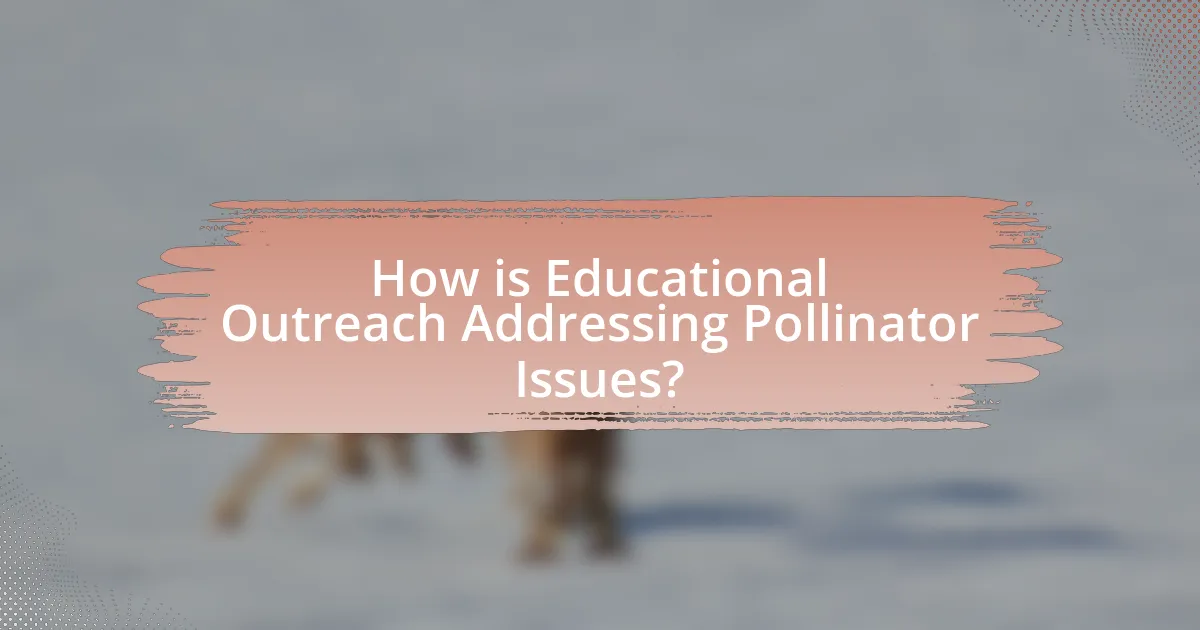
How is Educational Outreach Addressing Pollinator Issues?
Educational outreach is addressing pollinator issues by increasing public awareness and promoting conservation practices. Programs such as workshops, school curricula, and community events educate individuals about the critical role of pollinators in ecosystems and agriculture. For instance, the Pollinator Partnership’s educational initiatives have reached over 1 million people, emphasizing the importance of creating pollinator-friendly habitats. These outreach efforts are supported by research indicating that habitat loss and pesticide use significantly threaten pollinator populations, highlighting the need for informed community action.
What are the goals of educational outreach programs for pollinators?
The goals of educational outreach programs for pollinators include raising awareness about the importance of pollinators, promoting conservation efforts, and encouraging community involvement in pollinator-friendly practices. These programs aim to educate the public on the critical role that pollinators play in ecosystems and agriculture, as studies indicate that approximately 75% of global food crops depend on animal pollination. By providing information and resources, these outreach initiatives seek to foster a sense of responsibility and action among individuals and communities to protect pollinator habitats and support biodiversity.
How do these programs raise awareness about pollinator importance?
Programs raise awareness about pollinator importance through educational initiatives, community engagement, and outreach activities. These programs often include workshops, informational campaigns, and school curricula that highlight the critical role pollinators play in ecosystems and agriculture. For example, the Pollinator Partnership’s “National Pollinator Week” promotes awareness through events and resources that educate the public on pollinator species and their contributions to food production, with studies indicating that approximately 75% of global food crops depend on pollination. Additionally, local conservation efforts often involve citizen science projects that encourage community members to observe and report on pollinator activity, fostering a deeper understanding of their ecological significance.
What strategies are effective in engaging communities in pollinator conservation?
Effective strategies for engaging communities in pollinator conservation include educational outreach programs, community gardening initiatives, and citizen science projects. Educational outreach programs raise awareness about the importance of pollinators and provide information on how individuals can contribute to their conservation. For instance, workshops and seminars can teach community members about native plants that support pollinator populations. Community gardening initiatives encourage residents to create pollinator-friendly habitats, which can lead to increased local biodiversity. Additionally, citizen science projects, such as monitoring pollinator populations, actively involve community members in data collection, fostering a sense of ownership and responsibility towards conservation efforts. These strategies have been shown to enhance community involvement and promote sustainable practices that benefit pollinators.
How can schools incorporate pollinator education into their curriculum?
Schools can incorporate pollinator education into their curriculum by integrating hands-on activities, interdisciplinary lessons, and community engagement projects focused on pollinators. For instance, science classes can include studies on the life cycles and habitats of bees and butterflies, while art classes can involve creating pollinator-friendly gardens or crafts that highlight these species. Research indicates that experiential learning, such as field trips to local farms or nature reserves, enhances student understanding of ecological concepts, as shown in studies like “The Role of Experiential Learning in Environmental Education” by the National Science Teachers Association. Additionally, collaboration with local environmental organizations can provide resources and expertise, further enriching the educational experience.
What resources are available for educators on pollinator topics?
Educators have access to a variety of resources on pollinator topics, including online platforms, educational kits, and community programs. Notable resources include the Pollinator Partnership, which offers lesson plans and activities tailored for different grade levels, and the Xerces Society, which provides guides and resources on pollinator conservation. Additionally, the U.S. Fish and Wildlife Service has educational materials that focus on the importance of pollinators in ecosystems. These resources are designed to enhance understanding and promote conservation efforts among students and educators alike.
How can hands-on activities enhance learning about pollinators?
Hands-on activities enhance learning about pollinators by providing experiential learning opportunities that engage students actively in the subject matter. Engaging in activities such as planting pollinator gardens or conducting bee observations allows learners to directly interact with pollinators, fostering a deeper understanding of their roles in ecosystems. Research indicates that experiential learning can improve retention rates by up to 75%, compared to traditional lecture-based learning, which typically has a retention rate of only 5-10%. This active participation not only solidifies knowledge but also cultivates a sense of stewardship towards pollinator conservation.
What role do community initiatives play in supporting pollinators?
Community initiatives play a crucial role in supporting pollinators by creating habitats, raising awareness, and promoting sustainable practices. These initiatives often involve local groups and organizations that engage in activities such as planting native flowers, establishing community gardens, and organizing educational workshops. For instance, a study published in the journal “Ecological Applications” found that urban gardens significantly increase pollinator diversity and abundance, demonstrating the positive impact of community-led efforts on local ecosystems. Additionally, initiatives that educate the public about the importance of pollinators can lead to increased advocacy for policies that protect these vital species.
How can local gardens and parks contribute to pollinator habitats?
Local gardens and parks can significantly contribute to pollinator habitats by providing diverse plant species that offer food and shelter. These green spaces often include native flowering plants, which are essential for attracting and sustaining various pollinators such as bees, butterflies, and hummingbirds. Research indicates that urban gardens can increase local biodiversity; for instance, a study published in the journal “Urban Ecology” found that gardens with a variety of native plants support higher populations of pollinators compared to monoculture landscapes. Additionally, parks can serve as critical corridors that connect fragmented habitats, allowing pollinators to move freely and access resources necessary for their survival.
What are some successful examples of community-led pollinator projects?
Successful examples of community-led pollinator projects include the Pollinator Partnership’s “Bee City USA” initiative, which encourages cities to adopt policies that support pollinator habitats, and the “Pollinator Pathway” project in Connecticut, which promotes the creation of native plant corridors to support local bee populations. These projects have demonstrated effectiveness in increasing pollinator populations and enhancing biodiversity. For instance, Bee City USA has seen over 100 cities participate, leading to increased awareness and habitat restoration efforts. The Pollinator Pathway initiative has resulted in the planting of thousands of native plants, directly benefiting local ecosystems and pollinator health.
What practical steps can individuals take to support pollinators?
Individuals can support pollinators by planting native flowering plants that provide food sources throughout the growing season. Research indicates that native plants are more beneficial for local pollinators, as they have co-evolved with them and offer the necessary nutrients. Additionally, individuals can reduce pesticide use, as chemicals can harm pollinator populations; studies show that neonicotinoids, a common pesticide, are particularly detrimental to bees. Creating habitats such as bee hotels or leaving areas of the garden undisturbed can also provide nesting sites for solitary bees. Furthermore, participating in local conservation efforts or community gardens can enhance pollinator-friendly environments.
How can gardening practices be modified to benefit pollinators?
Gardening practices can be modified to benefit pollinators by incorporating native plants, reducing pesticide use, and creating diverse habitats. Native plants provide essential food sources and are adapted to local ecosystems, which enhances pollinator health and survival. Research indicates that gardens with a variety of flowering plants can support a higher diversity of pollinators, as different species are attracted to different flowers. Additionally, minimizing or eliminating pesticide application reduces harmful exposure to pollinators, which is crucial since studies show that neonicotinoids and other chemicals can significantly harm bee populations. Creating habitats such as nesting sites and water sources further supports pollinator populations, as these elements are vital for their reproduction and hydration.
What are the best plants to attract and support local pollinators?
The best plants to attract and support local pollinators include native wildflowers, such as coneflowers, black-eyed Susans, and milkweed. These plants provide essential nectar and pollen resources that are crucial for the survival of various pollinator species, including bees, butterflies, and hummingbirds. Research indicates that native plants are more effective in supporting local pollinator populations because they have co-evolved with these species, offering the specific resources they need. For example, milkweed is the sole host plant for monarch caterpillars, making it vital for their lifecycle. Additionally, studies show that gardens with a diverse array of native flowering plants can increase pollinator visitation rates by up to 50%, highlighting their importance in maintaining healthy ecosystems.
